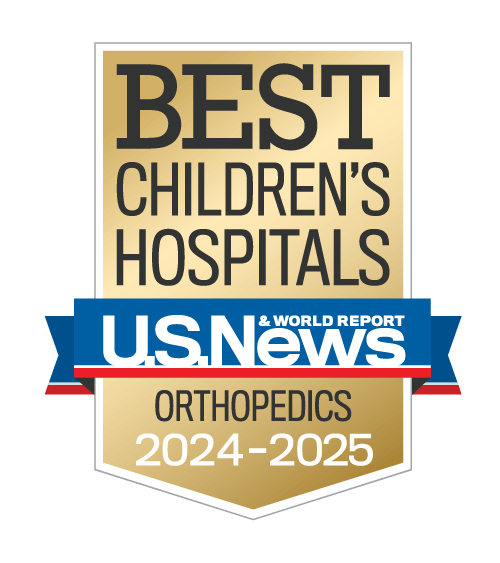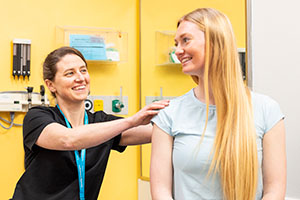Hip Fractures
What are hip fractures?
A hip fracture is a break in 1 or more bones of the hip or pelvis.
Not all hip fractures are the same. There are several places where these bones might break and several types of fractures. In a growing child’s hips and pelvis, the most common place for a fracture is where the muscles attach to bone. In children, the attachment point is not fully formed yet, and so it is a weak point.
If a child moves their legs very suddenly and forcefully — for example, during a fall or while playing sports — the muscles that attach to the hip or pelvic bones can pull away and break the bone (avulsion fracture).
For children, hip and pelvic fractures usually happen during car crashes or falls from snowboarding or bicycling. Any child can get a hip fracture. But very young children rarely do because their hip bones are more flexible.
Most hip fractures in children heal without a problem. Your child will have to give up some of their regular activities for about 6 to 12 weeks. Some children may need surgery to repair a hip fracture.
Orthopedics and Sports Medicine at Seattle Children's
What are the symptoms of hip fractures?
Signs that your child’s hip may be broken include:
- Severe pain
- Swelling or bruising
- Not wanting to put weight on the leg
- Pain with hip or leg movement
How are hip fractures diagnosed?
If your child has a mild injury around the hip or pelvis, the pain usually goes away after a few days. If the pain does not go away, your child should see an orthopedist for an exam and probably should have .
If your child has severe pain or pain that keeps them from doing their usual activities, your child’s doctor will take X-rays to look for fractures.
If the doctor does not see a fracture on the X-rays, it may be helpful to have advanced imaging, like an or , to help understand the reason for your child’s symptoms.
The doctor will also look for other problems that can cause hip pain such as:
Some problems that can cause pain can become serious if they are not found and treated early.
How are hip fractures treated?
Some children with hip fractures only need to limit their activities and use crutches while the bones knit back together. Others need a cast or surgery, and sometimes both, to keep the bones from shifting while the break heals. If the bones shift, it can cause lasting damage.
We typically use a spica cast (PDF) (Russian) (Spanish) (Vietnamese), without surgery, for children younger than age 5 or so. Most children older than age 5 need surgery because this is about the age when they start school and wearing a spica cast is not practical.
Surgery for Hip Fractures
If your child’s X-rays show the break is bad or the hip is broken in several places, the doctor will recommend an operation to put the bone back in place.
During the operation, the doctor puts screws or pins in the bone to keep it in place so it can heal well. Some children need to wear a cast after surgery to keep holding the broken bone in place and protect it as it heals.
Our doctors do both and open surgeries to treat broken hips.
Minimally invasive surgery for hip fractures
In minimally invasive surgery for a hip fracture, the doctor makes small cuts (incisions) on your child’s hip. Then, using X-ray guidance, the doctor puts screws or pins across the break.
Open surgery for hip fractures
In open surgery (also called open reduction) for a hip fracture, the doctor makes a larger cut on your child’s hip. This lets the doctor see the bone so they can put it back in place.
What to expect after surgery
If your child has surgery for a hip fracture, they will most likely be in the hospital about 1 or 2 days.
Sometimes, doctors use a spica cast along with surgery. The cast gives your child’s hip extra protection. Your child will wear the cast for about 4 to 6 weeks. If your child needs a cast, their team will give you details on how to care for your child while they are wearing it.
After the Fracture Heals
After your child is treated for a hip fracture, their doctor will closely monitor them for at least a year to make sure they are healing well.
Once the fracture has healed, most children have no further problems. But sometimes a problem does develop due to a fracture. For example, there may be a problem with the hip’s shape and function after a fracture (posttraumatic deformity). Or some bone in the hip may die if it did not get enough blood and nutrients for a while (avascular necrosis).
This may lead to problems as a child grows, like part of the bone growing less than the rest. Growth problems could lead to differences in the length of the child’s legs or trouble with the thighbone fitting, staying or moving well in the hip socket (hip dysplasia).
Your child’s team will check for signs of problems like this and also make sure you know what signs to watch for and when to call the doctor.
The team from Seattle Children’s Child and Young Adult Hip Preservation Program treats problems that might happen after a hip fracture. We focus on helping children and teens keep their natural hip and delay or avoid hip replacement. We also work with young adults in their 20s who are seeking care. For those who do need an artificial hip, we offer this option as well. Learn more about the Child and Young Adult Hip Preservation Program.
Why choose Seattle Children’s for hip fracture treatment?
 Seattle Children’s Orthopedics and Sports Medicine team provides care for children, teens and young adults with hip fractures. Within Orthopedics, members of our Fracture Program specialize in treating broken bones.
Seattle Children’s Orthopedics and Sports Medicine team provides care for children, teens and young adults with hip fractures. Within Orthopedics, members of our Fracture Program specialize in treating broken bones.
About 1 in 10 of all the fractures we treat are hip fractures.
Experts from our Child and Young Adult Hip Preservation Program may also be involved in care for hip fractures to protect or restore your child’s hip function if there are any concerns about the way the hip heals.
-
The fracture experts you need are here
- Your child’s team includes doctors, , and who specialize in children’s bones, muscles and joints. We have a wide range of experience in diagnosing and treating children with all types of pelvic and hip injuries and fractures.
- We involve specialists in , , and based on your child’s needs.
- Accurate diagnosis is the first step to effective treatment. Our team is experienced in making high-quality imaging studies using , and .
- Our first goal is to treat your child without surgery if we can. Many fractures that require surgery in adults can get better in children without surgery. Our pediatric orthopedists have the experience to choose the treatment that will lead to a good recovery for your child with the lowest risk of complications.
-
Our approach to surgery aims to get the best results for your child
- Before we recommend surgery, we look at your child as a whole person. Your child’s team will take many factors into account. These include how serious their condition is, the effects on their health, how much more they will grow and what results you can expect from treatment.
- We recommend surgery only when we believe it will give your child the best results. If your child needs surgery, our surgeons have many years of experience in treating children with hip fractures. Each of our hip surgeons is . Many have expanded fellowship training.
- We have the technology and skills to use imaging to guide hip surgery, if needed. This helps us place hardware, like screws, with precision. It also lets us see in real time the changes we make to the hip. Our operating rooms have the newest low-dose imaging equipment available.
- Dr. Todd Blumberg leads the Child and Young Adult Hip Preservation Program. He focuses on treating hip conditions from infancy into adulthood. Blumberg is the only dual fellowship-trained pediatric and hip preservation surgeon in the region. Seattle Children’s does more hip preservation surgeries for young people than any other center in the Pacific Northwest.
-
Care from birth through young adulthood
- We specialize in caring for kids. This means our experts have the knowledge, training and skills to treat the youngest patients, from babies through young adults. Young people with hip fractures may need different care than adults do, like treatment that takes their into account. Here, your child’s team has special training in the physical, emotional and social needs of young people.
- Babies, children and teens are still developing. When we evaluate your child’s condition, plan their treatment and provide their care, we carefully consider their growth. We think about how growth may affect their hip over time. We also consider how their hip may affect the rest of their development and health.
- If your child needs imaging that uses radiation, we use the lowest amount possible (PDF) to make the best image. We have a low-dose radiation X-ray machine, called the EOS. It makes safer full-body images. We also have the largest group of pediatric radiologists in the Northwest.
-
Support for your whole family
- Having a child with a hip fracture can be stressful for the whole family. From the first visit to follow-up, our team will work to give your child seamless care and make your experience here as easy on you as we can.
- Your child’s team does more than plan and provide care for your child. We also make sure you and your child understand your child’s condition and treatment options. We support you in making choices that are right for your family.
- For your convenience, our doctors see patients at locations in Seattle, Bellevue, Everett and Federal Way. We bring high-quality care closer to where you live.
- Seattle Children’s serves families from around the Northwest and beyond. We can help with financial counseling, education, housing, transportation, interpreter services, spiritual care and more. Our Child Life specialists, Family Resource Center and Guest Services are here to help. Read more about our services for patients and families.
-
Research and advances to improve care
- Our team members partner with experts around the world on research. Together, they work to understand the causes of hip conditions, improve the accuracy of diagnostic testing and create better surgical approaches.
- We track long-term results of our patients so we can improve care for young people with hip problems. For example, we ask patients about their experience before and after treatment to make sure our approach improves quality of life and function.
- Our surgeons have led research to reduce your child’s exposure to radiation from imaging tests, like and .
- As part of our constant work to improve results for kids, we developed standard plans (called protocols) to help your child recover after surgery.
- Learn more about current orthopedics research at Seattle Children’s.
Contact Us
Contact Orthopedics and Sports Medicine at 206-987-2109 for an appointment, a second opinion or more information.
Providers, see how to refer a patient.
Paying for Care
Learn about paying for care at Seattle Children’s, including insurance coverage, billing and financial assistance.


